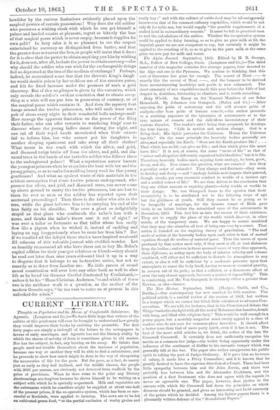The Alpine Journal. September, 1863. Edited by H. B. George,
M.A., Fellow of New College, Oxon. (Longman and Co,)—The third number of this magazine contains five average papers, four devoted to the Alps and one to the Pyrenees. We confess to thinking that this sort of literature has gone far enough. The ascent of Mont — is exactly like the ascent of Mont —, and the humour to be derived from mountaineering hardships and perils is now exhausted. The short summary of new expeditions made this year before the 12th of last August is, doubtless, interesting to climbers, and is worth recording.
Baby Worlds. An Essay on the Nascent Members of our Solar Household. By Jolumnes von Gumpach. (Dulau and Co.) —After exposing the pride of astronomy and the still greater pride of analysis—the base pride of human conceit,—the author proceeds. to a scathing exposure of the ignorance of astronomers as to the true nature of comets and the ridiculous inconsistency of their various theories. The reader's mini being thus prepared, he develops the true theory. "Life is motion and motion change. God is a living God ; His Spirit pervades the Universe. Hence the Universe has life." On the same principle the heavenly bodies generally are alive,.and especially the Earth. "Does not the Earth produce life ? . . That which has no life can give no life ; and that which gives life must have lite." It is not, of course, the same "mode of life" as that of minor and altogether differently organized individualities," but it is life. Therefore, heavenly bodies must, arguing from analogy, be born, grow, decay, and die. Now comes the question, what are comets ? Aro they a peculiar order of animals ? They change and fluctuate—they seem to develop and decay — and "analogy forbids us to impute their general, though steady, yet very eccentric conduct to worlds of a mature age and a settled course of life." We are thus driven to the conclusion that they are either nascent or expiring planets—baby worlds or worlds in their dotage. Mr. von Gumpach leans to the opinion that their eccentricity is to be attributed not to the faltering steps of ago but the giddiness of youth. Still they cannot be so young as to be incapable of marriage, for the famous comet of Mela gave birth to an infant before the astonished eyes of the astronomers in December, 1815. This fact lets us into the reason of their existence. They are to supply the place of the worlds which die,—or, in other words, of the temporary stars. We are happy to assure mankind that they may also abandon all fear of being run over by a comet. That notion is founded on the expiring theory of gravitation. "The real mode of action of the heavenly bodies upon each other is that of mutual repulsion through the medium of material space. Thus the waves of space produced by that action meet only, if they meet at all, at vast distances from the bodies ; and even in those assumed cases of very close approach, their difference, as acting upon the body of inferior velocity and volume combined, will either not be sufficient to disturb its atmosphere to any extent, or else it will be sufficient by a moderato pressure upon that atmosphere to cause the body itself, having no mass or cosmical gravity, to swerve out of its path ; so that a collision, or a disastrous effect of oven the very closest approach, becomes a matter of impossibility." This is comforting, and Mr. Von Gumpach is obviously either a greater than Newton, or else—insane.






























 Previous page
Previous page